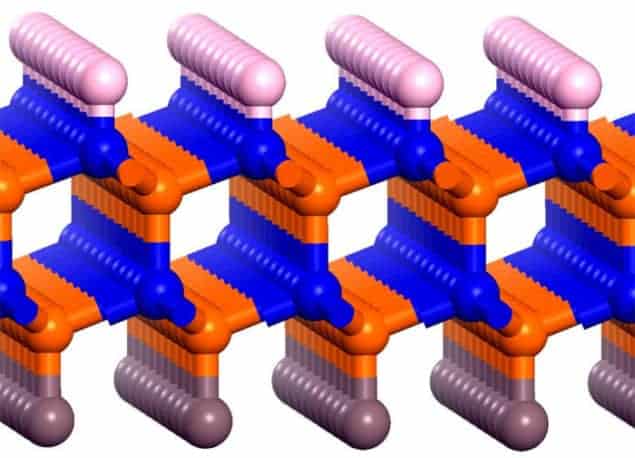
Infrared light could help split water into hydrogen and oxygen, despite the fact that infrared photons have less energy than is needed to drive the reaction. That is the claim of physicists in China, who have calculated that the reaction could proceed with the help of a bilayer catalyst that has a strong internal electric dipole. While making this catalyst in the lab would be very difficult, the researchers are now trying to come up with a more practical alternative. If they are successful, such catalysts would allow a far larger proportion of the solar spectrum to be used to generate hydrogen – perhaps making it a commercially viable source of hydrogen fuel.
In the 1970s some scientists envisaged that electricity generated by nuclear power stations could be used to create large quantities of hydrogen via the electrolysis of water. The hydrogen could then be used as a clean fuel for transportation or stored and then converted back into electricity to even out imbalances between electrical supply and demand. However, nuclear power has become unpopular in many countries following high-profile accidents and increased costs, and more than 90% of the world’s hydrogen is currently produced using fossil fuels.
An alternative method for making hydrogen is photochemical splitting, which was proposed in 1972 by the Japanese chemists Akira Fujishima and Kenichi Honda. Their scheme is usually realized in a suspension of catalyst particles in water. A particle absorbs a solar photon, which generates an electron–hole pair that stimulates the decomposition of water and liberates the hydrogen. In order to succeed, the band-gap energy associated with the creation of the electron–hole pair must be greater than 1.23 eV – which is the minimum needed to free-up the hydrogen. This corresponds to a near-infrared photon, so in theory photons with at least this energy (about 57% of photons from the Sun) can split water molecules.
Elusive band gaps
In the intervening years, researchers have tried to develop catalysts with band gaps hovering just above 1.23 eV but with little success. Today, several research groups are trying to develop catalysts that work under visible illumination, but these devices tend to be unstable under long-term irradiation. Worse still, traditional catalysts such as metal oxides have band gaps in the ultraviolet, which contains only 7% of the energy in the Sun’s rays.
Now, Jinlong Yang and colleagues at the University of Science and Technology of China in Hefei have set their sights on an even more ambitious goal: to make use of much more of the solar spectrum by developing a catalyst that works with infrared light well below the 1.23 eV threshold. While this might sound impossible from an energy point of view, catalysts often work by dividing a chemical process into several steps, each of which requires less energy than the overall process.
Using advanced computational algorithms based on density functional theory, the team designed an ultrathin catalyst comprising a bilayer of boron nitride functionalized with hydrogen atoms on the upper surface and fluorine atoms on the lower one. Fluorine has a very large electronegativity, which means that valence electrons would migrate to the lower surface of the bilayer to cause a potential difference of about 10 V between the top and bottom of the device (see figure above).
Migrating to opposite surfaces
The team calculates that the material has a band gap of just 0.85 eV, thereby allowing it to absorb infrared photons. The research suggests that when an electron–hole pair is created, the electron migrates to the top surface and the hole to the bottom surface, with the electron–hole pair thereby gaining 10 eV of energy. This is more than enough energy to split water and the researchers predict that hydrogen from water molecules would be reduced to hydrogen gas by the free electrons at the top surface, whereas oxygen from other water molecules would be oxidized to oxygen gas by the holes at the bottom.
There is a catch, however. The process leaves negative hydroxide ions bound to the top surface and positive hydrogen ions attached to the bottom. These ions would reduce the electric field across the catalyst, and photodecomposition would soon stop. The researchers suggest a pulsed electric field could remove the ions, but this would require additional energy and so would therefore reduce the efficiency of the process. However, any reduction in efficiency would be outweighed by the catalyst’s ability to exploit the energy of infrared photons.
Alternative structures
Creating the exact catalyst proposed by the team would be a challenging and costly process First it would involve making two boron-nitride monolayers. Then each monolayer would need to be functionalized separately and finally joined together back-to-back. Yang and colleagues are now working with experimentalists to try to develop alternative structures in the lab that yield the same results. “We are trying to find new materials that could be synthesized in bulk and then reduced down to the nanoscale,” says Yang. “These would then be easy to produce industrially.”
Hans Hilgenkamp, a physicist at the University of Twente in the Netherlands, is intrigued by the research but, in addition to the problem of needing to periodically remove ions from the surface to maintain the internal electric field, he sees another potential pitfall. The conduction and valence bands are on opposite surfaces of the structure. “In the new process,” he says, “you are not only exciting your electron to a higher energy level, but you are also moving it to a different position. I’m not sure how efficient this would be.”
The research will be described in an upcoming issue of Physical Review Letters.



